Themed collection Solid-State Photochemistry

Solid-state photochemistry
Welcome to this CrystEngComm themed issue entitled “Solid-State Photochemistry”.

CrystEngComm, 2016,18, 7175-7179
https://doi.org/10.1039/C6CE90146H
Recent progress in acentric core structures for highly efficient nonlinear optical crystals and their supramolecular interactions and terahertz applications
In this highlight, we review the present status of acentric core structures for highly efficient nonlinear optical organic crystals and discuss their distinctive supramolecular interactions and THz wave generation and detection applications.
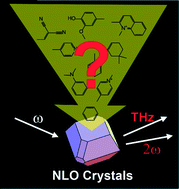
CrystEngComm, 2016,18, 7180-7203
https://doi.org/10.1039/C6CE00707D
Photo-induced motion of azo dyes in organized media: from single and liquid crystals, to MOFs and machines
Incorporation of photo-reversible azo dyes into molecular assemblies provides a new family of advanced optical and photo-mechanical materials that enable the direct transformation of light energy into mechanical motion.
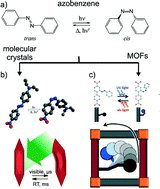
CrystEngComm, 2016,18, 7204-7211
https://doi.org/10.1039/C6CE01128D
Synchronised photoreversion of spirooxazine ring opening in thin crystals to uncover ultrafast dynamics
A ‘recover before destroy’ approach to minimise photoproduct build-up in solid state enables ultrafast studies of chemical reactions.
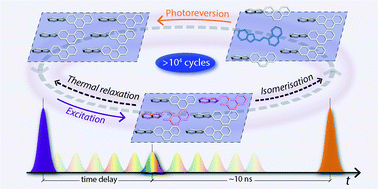
CrystEngComm, 2016,18, 7212-7216
https://doi.org/10.1039/C6CE01049K
Azobenzene crystals swim on water surface triggered by light
Crystals of 4-methoxyazobenzene move on water surface. The liquefied cis isomer acts as a fuel and light activates/deactivates the fuel.
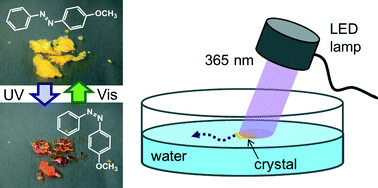
CrystEngComm, 2016,18, 7225-7228
https://doi.org/10.1039/C6CE00738D
A fast-response photochromic host–guest coordination polymer with a close-packed stacking structure
A photochromic phenyl-substituted viologen based derivative that is embedded in a layered zinc–carboxylate framework is shown to have a fast photoswitching behavior. A favorable geometry for intermolecular electron transfer is established by the sandwich-type π–π stacking structure between the photoactive host and guest components.
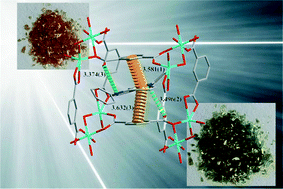
CrystEngComm, 2016,18, 7221-7224
https://doi.org/10.1039/C6CE00727A
Mechanical path to a photogenerated structure: ball milling-induced phase transition of a gold(I) complex
Ball milling of blue-emitting crystal 1B of gold(I) isocyanide complex 1 induces a phase transition to yellow-emitting powder 1YG, which has the same solid structure as the previously reported 1Y obtained upon photoirradiation of 1B.
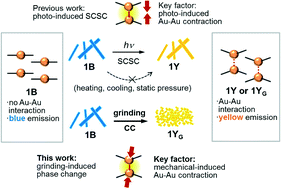
CrystEngComm, 2016,18, 7217-7220
https://doi.org/10.1039/C5CE02565F
Structural response to desolvation in a pyridyl-phenanthrene diarylethene-based metal–organic framework
A phenanthrene-based diarylethene linker with linear pyridyl connectivity, 4,4′-(9,10-bis(2,5-dimethylthiophen-3-yl)phenanthrene-2,7-diyl)dipyridine linker (TPDPy) was prepared and used to synthesize an air-stable metal–organic framework, UBMOF-3, (Zn3(BDC)3(TPDPy)1(DMF)1.5).
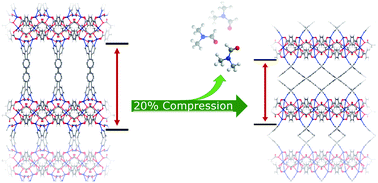
CrystEngComm, 2016,18, 7972-7977
https://doi.org/10.1039/C6CE01783E
Photodimerisation of the α′-polymorph of ortho-ethoxy-trans-cinnamic acid occurs via a two-stage mechanism at 343 K yielding 100% α-truxillic acid
Solid-state photodimerisation of o-ethoxy-trans-cinnamic acid at 343 K (α′ polymorph) proceeds to 100% conversion via a unique two-stage mechanism, both “Schmidt like” and “Kaupp like”.
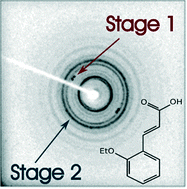
CrystEngComm, 2016,18, 7363-7376
https://doi.org/10.1039/C6CE00809G
Fluorescence behavior of 2,6,10-trisubstituted 4,8,12-triazatriangulene cations in solution and in the solid state
2,6,10-Trisubstituted triazatriangulene cation (TATA+) derivatives were synthesized, which showed a significantly red-shifted fluorescence band in the solid state.
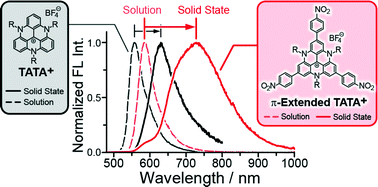
CrystEngComm, 2016,18, 7377-7383
https://doi.org/10.1039/C6CE00703A
Effect of crystal packing on the excitonic properties of rubrene polymorphs
Singlet fission (SF), the conversion of one singlet exciton into two triplet excitons, may increase the efficiency of organic photovoltaics by generating two carriers from one photon. Based on first-principles simulations, the monoclinic form of rubrene is expected to exhibit higher SF efficiency than the orthorhombic form.
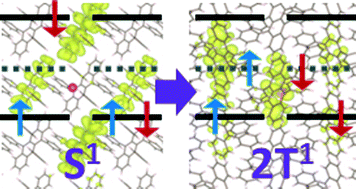
CrystEngComm, 2016,18, 7353-7362
https://doi.org/10.1039/C6CE00873A
Photodimerization of an olefin-containing pyridinium-based metal–organic complex and isomerization of its cyclobutane product upon recrystallization
An olefin-containing pyridinium-based metal organic complex underwent solid-state [2 + 2] photocycloaddition in 100% yield, and endowed the cyclobutane compound with an unusual rcct-configuration by recrystallization.
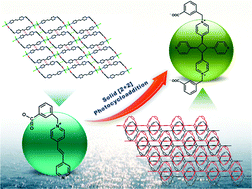
CrystEngComm, 2016,18, 7347-7352
https://doi.org/10.1039/C6CE00724D
Crystal structure of the meta-stable intermediate in the photomechanical, crystal-to-crystal reaction of 9-tert-butyl anthracene ester
NMR crystallography is used to determine the crystal structure of a meta-stable intermediate in a photomechanical transformation.
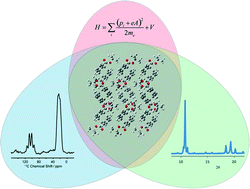
CrystEngComm, 2016,18, 7319-7329
https://doi.org/10.1039/C6CE00742B
Electro-optic crystals grown in confined geometry with optimal crystal characteristics for THz photonic applications
A new crystal engineering technique for growing large-area organic electro-optic crystals in a confined geometry with a desired thickness, optimal for THz photonics, is developed and the correlations between THz generation characteristics and crystal characteristics are investigated.
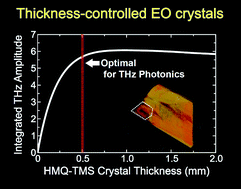
CrystEngComm, 2016,18, 7311-7318
https://doi.org/10.1039/C6CE00958A
Optical properties of metal–organic networks from distributed atomic polarizabilities
Metal–organic networks have become very popular in view of various chemical and physico-chemical applications. Here, a new approach to explore their potentialities as linear optical materials is discussed.
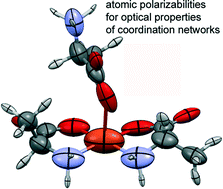
CrystEngComm, 2016,18, 7339-7346
https://doi.org/10.1039/C6CE00918B
Control of the photochromic behavior of cobaloxime complexes with salicylidene-3-aminopyridine and 2-cyanoethyl groups by dual photoisomerization
The lifetime of colored species of photochromic derivatives significantly changed after the photoisomerization of the 2-cyanoethyl group.
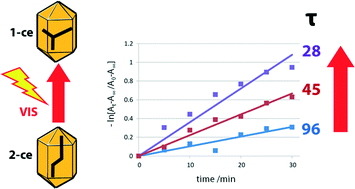
CrystEngComm, 2016,18, 7330-7338
https://doi.org/10.1039/C6CE01005A
Photoinduced topographical changes on microcrystalline surfaces of diarylethenes
Photoinduced topographical changes were observed above Tg of their open-ring isomers.
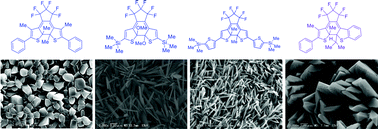
CrystEngComm, 2016,18, 7229-7235
https://doi.org/10.1039/C6CE00718J
1,2,4-Triazole-based molecular switches: crystal structures, Hirshfeld surface analysis and optical properties
A series of eight closely related N-salicylidene-4-amino-1,2,4-triazole compounds has been prepared. Their crystal structures were elucidated by single-crystal X-ray diffraction and optical properties were examined by diffuse reflectance spectroscopy. Noncovalent interactions detected in these compounds were, for the first time, analyzed by means of Hirshfeld surface analysis.

CrystEngComm, 2016,18, 7284-7296
https://doi.org/10.1039/C6CE00749J
Optical properties of regioregular poly(3-hexylthiophene) aggregates from fully atomistic investigations
We report on a first-principle theoretical investigation of the optical absorption and emission spectra of poly(3-hexylthiophene) (P3HT) aggregates by means of a multiscale all-atom hybrid approach, which combines molecular dynamics simulations, quantum-chemical calculations, and solving of a Frenkel–Holstein model.
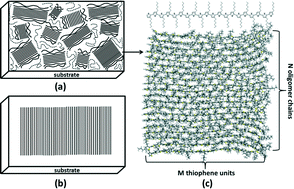
CrystEngComm, 2016,18, 7297-7304
https://doi.org/10.1039/C6CE00645K
Mechanical motion of molecular crystals induced by [4 + 4] photodimerisation
Narrow plate-like microcrystals of a stilbene-type compound substituted with anthracene and indanone groups bend upon irradiation with ultraviolet light.
![Graphical abstract: Mechanical motion of molecular crystals induced by [4 + 4] photodimerisation](/en/Image/Get?imageInfo.ImageType=GA&imageInfo.ImageIdentifier.ManuscriptID=C6CE00848H&imageInfo.ImageIdentifier.Year=2016)
CrystEngComm, 2016,18, 7305-7310
https://doi.org/10.1039/C6CE00848H
Turn-on mode fluorescence photoswitching of diarylethene single crystals
Photochromic diarylethene derivatives having benzo[b]thiophene S,S-dioxide groups underwent turn-on mode fluorescence photoswitching in the single-crystalline phase.
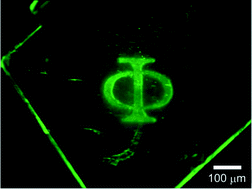
CrystEngComm, 2016,18, 7241-7248
https://doi.org/10.1039/C6CE00725B
The effect of thermal expansion on photoisomerisation in the crystals of [Co(NH3)5NO2]Cl(NO3): different strain origins – different outcomes
The effect of thermal strain on the rate of photoisomerization is qualitatively different from the effect of strain generated by elastic loading.
![Graphical abstract: The effect of thermal expansion on photoisomerisation in the crystals of [Co(NH3)5NO2]Cl(NO3): different strain origins – different outcomes](/en/Image/Get?imageInfo.ImageType=GA&imageInfo.ImageIdentifier.ManuscriptID=C6CE00840B&imageInfo.ImageIdentifier.Year=2016)
CrystEngComm, 2016,18, 7276-7283
https://doi.org/10.1039/C6CE00840B
Cooperative elastic switching vs. laser heating in [Fe(phen)2(NCS)2] spin-crossover crystals excited by a laser pulse
Ultrafast photoswitching in spin-crossover crystals induces lattice expansion, which drives cooperative and self-amplified spin-state transformation.
![Graphical abstract: Cooperative elastic switching vs. laser heating in [Fe(phen)2(NCS)2] spin-crossover crystals excited by a laser pulse](/en/Image/Get?imageInfo.ImageType=GA&imageInfo.ImageIdentifier.ManuscriptID=C6CE00659K&imageInfo.ImageIdentifier.Year=2016)
CrystEngComm, 2016,18, 7269-7275
https://doi.org/10.1039/C6CE00659K
Photo-induced linkage NO isomers in the dinitrosyl complex [Ru(NO)2(PCy3)2Cl](BF4) identified by photocrystallography and IR-spectroscopy
Multiple light-induced metastable NO linkage isomers are detected in the dinitrosyl compound [Ru(NO)2(PCy3)2Cl](BF4) by a combined photocrystallographic and infrared analysis.
 identified by photocrystallography and IR-spectroscopy](/en/Image/Get?imageInfo.ImageType=GA&imageInfo.ImageIdentifier.ManuscriptID=C6CE00735J&imageInfo.ImageIdentifier.Year=2016)
CrystEngComm, 2016,18, 7260-7268
https://doi.org/10.1039/C6CE00735J
Photoinduced stepwise bending behavior of photochromic diarylethene crystals
A new type of photomechanical motion of photochromic diarylethene crystals has been presented.
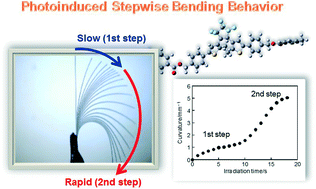
CrystEngComm, 2016,18, 7236-7240
https://doi.org/10.1039/C6CE00607H
Polymorphism driven optical properties of an anil dye
Red crystals of N,N′-bis(3-methoxysalicylidene)-1,5-diiminonaphthalene were obtained after Schiff base condensation in ethanol. Recrystallization from acetone afforded yellow crystals, a process which is reversible and reproducible.
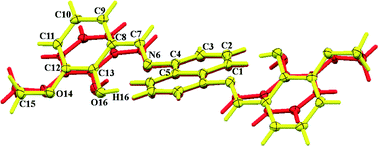
CrystEngComm, 2016,18, 7249-7259
https://doi.org/10.1039/C6CE00266H
About this collection
The issue focuses on photochemical reactions and photophysical structure and properties of solid-state materials, ranging from the crystalline state to interfacial structures that involve at least one solid phase.